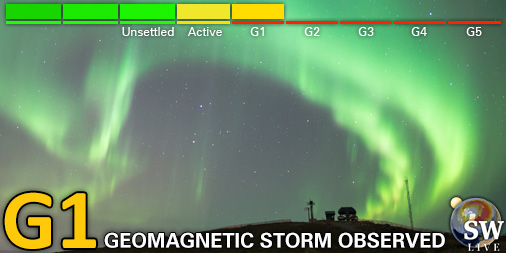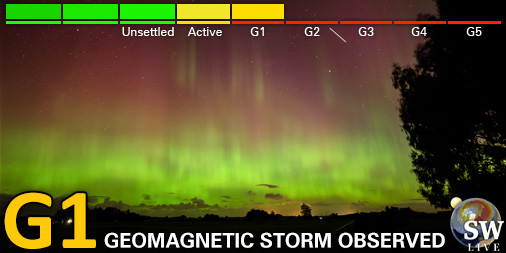Previsioni Meteorologiche Spaziali - Discussione
Emesso: 2025 Apr 04 1230 UTC
Preparati dal Dipartimento di Commercio degli Stati Uniti, NOAA, Centro di Previsione Meteorologica Spaziale e elaborati da SpaceWeatherLive.com
Attività solare
Sommario di 24 ore
Solar activity was at low levels. Only low level C-class flares were observed from Regions 4048 (S16E07, Fkc/beta-gamma) and 4045 (S14W25, Cao/beta). Slight decay and separation was observed in Region 4048. Other activity included an approximate 4 degree filament eruption centered near S20W05 at 03/0334 UTC. An associated faint, narrow CME was observed off the SSE limb at 03/0412 UTC. Modelling of the event showed the majority of the CME south of the Sun-Earth line. However, a potential grazing early on 06 Apr cannot be ruled out.Previsione
Solar activity is likely to be moderate (R1-R2, Minor-Moderate) with a slight chance for X-class flares (R3, Strong) on 04-06 Apr.Particelle energetiche
Sommario di 24 ore
The greater than 2 MeV electron flux was at normal to moderate levels. The greater than 10 MeV proton flux continued to be enhanced around 1 pfu, but well below the S1 (Minor) threshold.Previsione
The greater than 2 MeV electron flux is expected to be at normal to moderate levels on 04 Apr. A chance for high levels is likely on 05-06 Apr due to CH HSS influence. There is a slight chance for a greater than 10 MeV proton event on 04-06 Apr.Vento Solare
Sommario di 24 ore
Solar wind parameters continued to be enhanced under persistent CME influence. Total field ranged from 2-11 nT while the Bz component was between +/-10 nT. Solar wind speed averaged around 440 km/s. Phi angle was positive.Previsione
Solar wind parameters are expected to transition into a negative polarity CIR/CH HSS on 04 Apr. HSS influence is expected to persist through 06 Apr. There is a chance for a grazing from the 03 Apr CME early on 06 Apr, however confidence is low.Geospaziale
Sommario di 24 ore
The geomagnetic field was at quiet to unsettled to G1 (Minor) levels due to persistent CME effects.Previsione
The geomagnetic field is expected to be at unsettled to G1 (Minor) storming on 04-05 Apr due to CIR/CH HSS effects. Quiet to unsettled conditions is expected on 06 Apr as HSS effects gradually wane.I dati attuali suggeriscono che ci sia un'alta possibilità per la comparsa dell'aurora alle seguenti regioni ad alta altitudine nel futuro prossimo
ReykjavikI dati attuali suggeriscono che ci sia una possibilità moderata per la comparsa dell'aurora alle seguenti regioni ad alta altitudine nel futuro prossimo
TórshavnOulu, Rovaniemi, Sodankylä, Utsjoki
Kirkenes, Tromsø, Trondheim
Murmansk
Kiruna, Luleå, Umeå
I dati attuali suggeriscono ci sia una lieve possibilità perché l'aurora compaia alle seguenti regioni ad alta altitudine nel futuro prossimo
KuopioBergen
Arkhangelsk
Sundsvall
I dati attuali suggeriscono che ci sia una lieve possibilità perché l'aurora compaia alla seguenti regioni di media latitudine nel futuro prossimo
TamperePetrozavodsk
Ultime notizie
Ultimi messaggi dal forum
Supporta SpaceWeatherLive.com!
Molte persone vengono su SpaceWeatherLive per seguire l'attività del Sole o sapere se ci sia la possibilità di vedere l'aurora, ma a maggior traffico corrispondono costi maggiori. Considerate una donazione se vi piace SpaceWeatherLive così che possiamo mantenere online il sito web!

Ultimi avvisi
21:03 UTC - Indice di potenza emisferica
Il modello OVATION prevede che l'indice di potenza emisferica raggiunga i 75GW alle 21:49 UTC
13:15 UTC - Attività geomagnetica
Tempesta geomagnetica G1 minore (Kp5) Soglia Raggiunta: 13:07 UTC
12:33 UTC - Indice di potenza emisferica
Il modello OVATION prevede che l'indice di potenza emisferica raggiunga i 75GW alle 13:21 UTC
00:15 UTC - Attività geomagnetica
Tempesta geomagnetica G1 minore (Kp5) Soglia Raggiunta: 23:59 UTC
giovedì, 3 aprile PM
20:15 UTC - Attività geomagnetica
Tempesta geomagnetica G1 minore (Kp5) Soglia Raggiunta: 20:02 UTC
Notizie sul meteo spaziale
| Ultimo brillamento X | 2025/03/28 | X1.1 |
| Ultimo brillamento M | 2025/04/01 | M2.5 |
| Ultima tempesta geomagnetica | 2025/03/27 | Kp5 (G1) |
| Giorni senza macchie | |
|---|---|
| Ultimo giorno senza macchie | 2022/06/08 |
| Media mensile Numero di Macchie Solari | |
|---|---|
| marzo 2025 | 134.2 -20.4 |
| aprile 2025 | 143 +8.8 |
| Ultimi 30 giorni | 129.8 -16.3 |





